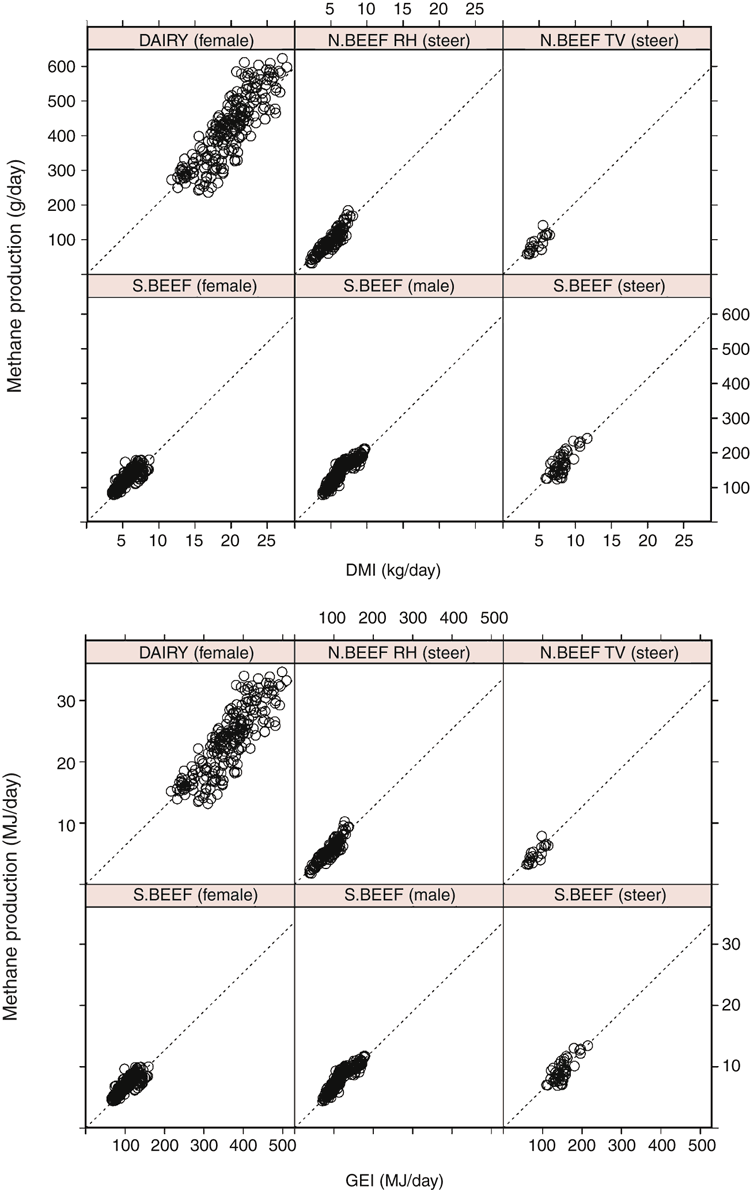A universal equation to predict methane production of forage-fed cattle in Australia
E. Charmley A G , S. R. O. Williams B , P. J. Moate B , R. S. Hegarty C , R. M. Herd D , V. H. Oddy D , P. Reyenga E , K. M. Staunton E , A. Anderson F and M. C. Hannah BA CSIRO Agriculture, Private Mail Bag PO Aitkenvale, Townsville, Qld 4814, Australia.
B Department of Economic Development, Jobs, Transport and Resources, 1301 Hazeldean Road, Ellinbank, Vic. 3821, Australia.
C Environmental and Rural Sciences, University of New England, Armidale, NSW 2351, Australia.
D NSW Department of Primary Industries, Beef Industry Centre, University of New England, Armidale, NSW 2351, Australia.
E Department of the Environment, GPO Box 787, Canberra City, ACT 2601, Australia.
F Queensland Department of Agriculture and Fisheries, Spyglass Beef Research Facility, MS 99, Charters Towers, Qld 4820, Australia.
G Corresponding author. Email: ed.charmley@csiro.au
Animal Production Science 56(3) 169-180 https://doi.org/10.1071/AN15365
Submitted: 10 July 2015 Accepted: 6 November 2015 Published: 9 December 2015
Journal Compilation © CSIRO Publishing 2016 Open Access CC BY-NC-ND
Abstract
The methods for estimating methane emissions from cattle as used in the Australian national inventory are based on older data that have now been superseded by a large amount of more recent data. Recent data suggested that the current inventory emissions estimates can be improved. To address this issue, a total of 1034 individual animal records of daily methane production (MP) was used to reassess the relationship between MP and each of dry matter intake (DMI) and gross energy intake (GEI). Data were restricted to trials conducted in the past 10 years using open-circuit respiration chambers, with cattle fed forage-based diets (forage >70%). Results from diets considered to inhibit methanogenesis were omitted from the dataset. Records were obtained from dairy cattle fed temperate forages (220 records), beef cattle fed temperate forages (680 records) and beef cattle fed tropical forages (133 records). Relationships were very similar for all three production categories and single relationships for MP on a DMI or GEI basis were proposed for national inventory purposes. These relationships were MP (g/day) = 20.7 (±0.28) × DMI (kg/day) (R2 = 0.92, P < 0.001) and MP (MJ/day) = 0.063 (±0.008) × GEI (MJ/day) (R2 = 0.93, P < 0.001). If the revised MP (g/day) approach is used to calculate Australia’s national inventory, it will reduce estimates of emissions of forage-fed cattle by 24%. Assuming a global warming potential of 25 for methane, this represents a 12.6 Mt CO2-e reduction in calculated annual emissions from Australian cattle.
Additional keywords: beef, dairy, emissions intensity, tropical.
Introduction
Australia reports its national greenhouse accounts using country-specific Tier 2 methods (Department of the Environment 2014), as recommended by the IPCC (2000). Enteric fermentation by cattle is responsible for ~52% of total agricultural emissions of greenhouse gases (total was 87.4 million t CO2-e in 2012) and 8.4% of the total national emissions (Australian Greenhouse Emissions Information System 2014). In the Australian Inventory of Greenhouse Gases, methane emissions from forage-fed cattle currently rely on two methods. The method for dairy cattle and temperate beef cattle is based on an equation reported by Blaxter and Clapperton (1965) and subsequently corrected by Wilkerson et al. (1995). The method for tropical beef cattle is based on an equation originally reported by Kurihara et al. (1999), but subsequently modified by Hunter (2007). Both methods rely on an estimation of feed intake. For dairy cattle, feed intake is based on the equation of Minson and McDonald (1987) corrected for milk production (Standing Committee on Agriculture 1990). For beef cattle, dry matter intake (DMI) is derived from bodyweight (BW) and BW gain (Minson and McDonald 1987). In the most comprehensive Australian study of tropical diets, Kennedy and Charmley (2012) concluded that the Kurihara et al. (1999) method for estimating methane emissions from tropical cattle overestimated methane production by ~30%. Consequently, the Australian Department of Environment commissioned a re-analysis of all recent, available Australian data collected from open-circuit respiration chambers to determine whether it was appropriate to reconsider the Tier 2 method used by Australia for estimating enteric methane emissions from forage-fed cattle.
In the present study, data were collated with the objective of deriving a relationship or relationships involving DMI or gross energy intake (GEI) for estimating methane production (MP) from all classes of cattle in Australia fed or grazing on a wide range of diets and diet qualities.
Materials and methods
All experiments that contributed to the dataset were approved under the Australian code of practice for the care and use of animals for scientific purposes (NHMRC 2004), according to the respective State in which the experiments were conducted. Data for the analysis were primarily sourced from published datasets involving only data collected using open-circuit respiration chambers from individual cattle that were fed >70% forage in the ration, on diets which were not expected to reduce methane emissions or yield. Data were sourced from the following four sites: Department of Economic Development, Jobs, Transport and Resources Victoria for the dairy data (DAIRY); New South Wales Department of Primary Industries and the University of New England for the temperate (southern) beef data (S.BEEF); and CSIRO Rockhampton and Townsville for the tropical (northern) beef data (N.BEEF; Table 1). To maintain intellectual-property rights of contributing sources, the data provided comprised only sex, liveweight, DMI, MP (g/day, MJ/day), treatment design and an experimental designation, which included some information on diet composition. For tropical diets, gross energy (GE) concentration of the diets was also provided. This was necessitated as the mean GE concentration of tropical diets used by Kennedy and Charmley (2012) was lower than the standard value of 18.4 MJ/kg DM used for temperate forages in the present paper and in current accounting methods. For all data, a constant energy value for methane of 55.22 MJ/kg methane (Brouwer 1965) was adopted. There was a total of 1034 observations, including 220 dairy observations, 680 temperate beef observations and 133 tropical beef observations (Table 1). The northern beef data comprised 114 observations on Brahman steers at Rockhampton and 19 observations on Brahman steers at Townsville.
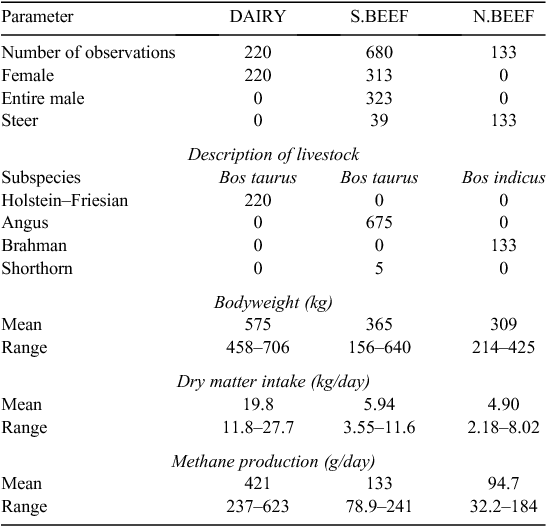
|
Description of the feeds
The dairy data were taken from five published experiments using lactating cows (Grainger et al. 2008, 2010; Moate et al. 2013; Williams et al. 2013; Deighton et al. 2014) and five unpublished experiments. The cows were at different stages of lactation and were fed on a wide variety of diets containing in excess of 70% forage (pasture, pasture hay, pasture silage, or lucerne hay) and between 0 and 30% concentrate (barley, triticale, or wheat). None of these diets contained any known methane mitigants (Table 2).

|
The temperate beef data were taken from a project designed to evaluate the phenotypic and genetic variation in methane production, described by Donoghue et al. (2013) and Herd et al. (2014). Growing Angus heifers, bulls and steers were fed a commercial lucerne and oaten hay chaff ration at ~1.2 times maintenance (Table 2). A small number of observations (15) were also incorporated from two separate studies conducted at the University of New England with Shorthorn and Angus cattle (J. Velazco, unpubl. data).
The tropical beef data collected on growing Bos indicus steers were previously published by Kennedy and Charmley (2012). In total, 23 diets were evaluated that included the tropical grasses black speargrass (Heteropogon contortus), buffel grass (Cenchrus ciliaris) bisset creeping bluegrass (Bothriochloa insculpta), mitchell grass (mixture of Astrebla lappacea, Astrebla elymoides) and rhodes grass (Chloris gayana). Speargrass, buffel grass and bluegrass were given at contrasting levels of maturity and speargrass was also fed with or without urea. Grasses were fed alone or in combination with the legumes dolichos (Dolichos lablab), burgundy bean, (Macroptilium bracteatum), stylo cv. verano (Stylosanthes hamata) and lucerne (Medicago sativa). All diets were fed ad libitum as hays and no concentrate feeds were given. Data for diets containing leucaena, presented in the original paper (Kennedy and Charmley 2012) were excluded because leucaena was shown to reduce methane emissions. Data from a further three grasses (mitchell grass hay, rhodes grass hay and a mixed Urochloa, rhodes, buffel pasture) from trials conducted in Townsville were included to expand the dataset (N. W. Tomkins, unpubl. data).
Methane measurement
All measurements were made in open-circuit respiration chambers from which methane concentration was measured. However, the procedures at the four sites differed to some degree and the methods are summarised below.
Dairy data: Ellinbank, Victoria
The physical dimensions and major characteristics of the two open-circuit respiration chambers and emission calculations have been described previously (Grainger et al. 2007). Operation of the chambers was as described by Williams et al. (2013). Briefly, cows were fed and milked twice a day and methane measurements were made for 22 h per day on two consecutive days. During the two 1 h periods when the doors were open for milking, it was assumed that the rate of methane production was the same as during the hour before door opening. Methane was detected using an infrared sensor (GFx 0–500 mg/kg, Servomex Group, Crowborough, UK). Temperature and humidity were controlled and intake and exhaust air were sequenced to the analyser in a 12-min cycle (4 min outside air, 4 min exhaust air Chamber 1, 4 min exhaust air Chamber 2). Methane measurements taken in the last 2 min of each 4 min sampling period were used to determine emissions. The methane concentrations, exhaust air flow rates, relative humidity, temperature and gas pressure at the inlet and exhaust were recorded at 10 s intervals. Each chamber was calibrated at the beginning and end of the experiments, with additional calibrations between experiment cycles as scheduling permitted. Calibration consisted of injecting individual gases at controlled rates while running the regular data-collection process.
Temperate (southern) beef data: Armidale, New South Wales (NSW)
A full description of the methane testing facility located on the University of New England campus in Armidale, NSW, Australia, was given by Hegarty et al. (2014) and Herd et al. (2014). It comprises 10 open-circuit respiration chambers, each of 20 m3 internal volume and with an air flow rate of 1.6 m3/min. The respiration-chamber ambient air flow is reliant on negative pressure in the system, achieved by 2 × Aerovent HPE400 3-phase fans (Aerovent Australia, Melbourne, Vic., Australia) placed in parallel at the exhaust of the system. Exhaust air from each chamber flows directly into a flow control manifold composed of 10 mass-flow meters (Model ST75V, Fluid Components International, San Marcos, CA, USA). A continuous subsample of gas is drawn from each gas line immediately after each flow meter, dried through a custom refrigerated drier (AZCO Instruments, Auckland, NZ) and methane concentrations are measured by a Servomex analyser Model 4100C1 (Servomex Group) fitted with an infrared detector for methane (GFx1210, 0–500 ppm) over 10 s after a 40 s purge time. Gas production was determined every 9 min per chamber for a period of 20 s. The Servomex was calibrated for methane with two high-purity gas standards (low: 0 mg/kg, and high: 97.5 mg/kg methane). Methane recovery through the chambers was measured between studies by a continuous release of methane standard. Methane production was measured over 2 × 24 h consecutive periods, with animals fed once a day in the morning.
Tropical (northern) beef data: Rockhampton, Queensland
Full details were provided by Kennedy and Charmley (2012) and Tomkins et al. (2011). Briefly, in each of two chambers, animals were fed once daily in the morning at a level equivalent to the feeding level established in the previous 5 days during pen feeding. Methane emissions were measured over one 24 h period. Air was sampled from alternate chambers every 3 min and methane output was calculated from air sampled over the last 2 min of each 3 min sampling cycle. Calibrations of the methane analyser were checked every 2 h and system recoveries were assessed after each experimental period. If feed intake on the day of measurement was less than 90% that of the previous day, the measurement was repeated several days later.
Tropical (northern) beef data: Townsville, Queensland
Four open-circuit chambers were used with methane emissions collected over two consecutive days. Each chamber was 4.0 × 2.4 × 2.4 m and was constructed of a tubular galvanised steel frame over which 4.5 mm clear polycarbonate was attached providing full visibility for each animal. A modified squeeze crush within each chamber defined a confinement area that accommodated cattle of different sizes. Each chamber was fitted with a door (1050 × 2100 mm) at either end for entry and exit of the animal. Animals were fed at ad libitum levels established in the days before animals entered chambers. Measurements were taken over 23 h and extrapolated to a 24 h methane production. Intake air was sourced external to the animal building, with chamber air vented through the roof line. Inline fans (TD800/200N, Fantech, Melbourne, Vic., Australia) fitted with variable speed controllers maintained flow rates of 100 L/s and a slight negative pressure within each chamber. Relative humidity and temperature (HMT 330, Vaisala, Melbourne, Vic., Australia) and pressure (QBM75-1U/C, Siemens, Zurich, Switzerland) sensors installed in each chamber permitted air flow to be corrected to standard temperature and pressure. Air flow was measured on the exhaust with thermal flow sensors (SS20.500 SCHMIDT® Flow sensor, St Georgen, Germany). Air for gas analysis was drawn from a point in the exhaust duct through polyurethane tubing at 4.5 L/min, using a micro diaphragm pump located between a multiport gas-switching unit (SW & WS Burrage, Ashford, Kent, UK) and membrane drier (Perma Pure LLC, Toms River, NJ, USA). Following particulate filtering and dehumidifying using a four pot refrigerated drier (AF30-02, SMC Pneumatics Australia, Sydney, NSW, Australia), air samples entered the multiport gas-switching unit that sampled each chamber and two outside air ports for 180 s. Air samples then passed through the membrane drier and were metered through independent rotameters before analysis for methane (GFx Infrared, 0–500 mg/kg, Servomex 4100, Servomex Group). Sampling events, internal monitoring of chamber conditions and data management were handled by Innotech® processors (Genesis II, Innotech®, Brisbane, Australia) using digital I/O at 4–20 mA. All data were compiled in a dedicated computer by using a structured query language database. Daily (24 h) methane emissions were calculated by averaging the last 90 s of each sampling period. System recoveries were assessed by releasing methane (99.9% purity) at known rates (g/min) and regressed against chamber readings between each experimental period.
Data analyses
The relationships between MP (g/day or MJ/day) and DMI (kg/day) or GEI (MJ/day) were analysed for the combined data in a meta-analysis using linear mixed-effect models (Galwey 2006) by REML in Genstat (17th edn, 2014, VSN International, Hemel Hempstead, UK). The mixed-effect models consisted of fixed effects to characterise the relationships between MP and intake, and random effects to characterise the variance structure of the data.
The fixed effects included a linear term in DMI (or GEI) by factorial effects of cattle class (DAIRY, S.BEEF or N.BEEF), cattle breed (Shorthorn versus Angus) within S.BEEF, and sex (female, male or steer). Also included were quadratic terms in DMI by cattle class.
The random effects comprised variance components for experiment, period within experiment, treatment within experiment, and residuals. The variance component for experiment accounted for variance among experiments within each class. The period-within-experiment variance component was relevant only to two short-term, dairy crossover trials. The periods in some longer-term dairy experiments related to measurements taken in autumn and spring, over 2 years. These long-term periods were considered as separate experiments in the present analysis. The treatment-within-experiment variance component accounted for feed-type effects. In addition to these, separate residual variances for the four locations from which the data were sourced, were included in the model. Finally, an additional variance for dairy experiment was included, allowing for larger variance among dairy experiments than among beef experiments. This random-effect structure was employed in all analyses.
The overall aim of the present paper was to present the simplest satisfactory relationship between MP and intake. Accordingly, the fixed-effects model was progressively simplified by removing terms that were not statistically significant or that were physically implausible. The initial full model was as follows:

where x is either DMI or GEI, µ is a constant (intercept). Other Greek letters indicate coefficients for linear and quadratic effects in DMI. Lower-case Latin letters are factorial fixed effects. Upper-case Latin letters are random effects, assumed to be normally distributed, and ε is a normally distributed residual error. Subscript l = 1…4 indicates the location of experiment, e denotes the experiment from which the data were derived, t indexes the treatment within experiment, p denotes the period (within dairy crossover experiments), and i identifies the observation within levels of location, experiment, treatment and period. Subscript k = 1…3, indicates the class of cattle (DAIRY, S.BEEF, N.BEEF), j = 1…3, the cattle sex (female, male, steer), and q = 1…3, the cattle breed (Shorthorn, Angus, other). The variances of the random effects are variance among experiments,

extra variance among dairy experiments,

variance among periods,

variance among fodder treatments,

and residual error variances for the four locations,

Models were tested with and without intercepts. The minimal model, that included just a linear term in DMI through the origin, and random (noise) effects, was as follows:

A generalised R2 statistic (Nakagawa and Schieizeth 2013), suitable for use in mixed-effect models, was calculated for each model. Fixed effects were tested using F-tests from accumulated analysis of deviance, and contrast Student’s t-tests derived from coefficient estimates and their variance–covariance matrix. Distributional assumptions of normality and constant variance were checked graphically using histograms, normal quantile plots and plots of residuals versus fitted values.
The predictive capability of the final model was assessed by cross validation in which each of the 29 experiments was successively excluded from the calibration data, to which the model was refitted, with the excluded data being used as test data. The root mean square of percentage discrepancies between the cross-validation predicted and observed test data MP for all 29 experiments was used to summarise precision of prediction. Percentage, rather than absolute, discrepancy was used because of its stability for these data, consistent with variance increasing with mean, but coefficient of variation remaining constant.
Results
Methane production and DM intake
A graph of MP versus DMI data indicated a linear relationship, possibly through the origin, with the spread of data observed to increase with increasing DMI (Fig. 1).
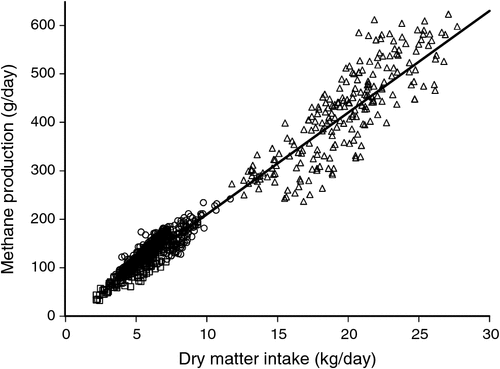
|
In the initial meta-analysis model, Shorthorn did not differ significantly (breed effects P > 0.05) from Angus in intercept or slope of DMI. Accordingly, breed was excluded from all subsequent models. However, there were significant effects of cattle class (P = 0.03) and sex (P < 0.001) that remained significant in the model with breed effects excluded. Slope and intercept estimates for these are shown in Table 3. Some of the intercepts were significantly different from zero (S.BEEF (male), P = 0.032, and S.BEEF (steer), P < 0.001). The estimated slopes were not significantly different by class (P = 0.74), but were different by sex (P < 0.001).

|
When the lines were constrained to pass through the origin, slope estimates were significantly different among classes (P = 0.042) and sexes (P < 0.001; Table 4, Fig. 2). Pairwise tests of slope estimates between class by sex groups are given in Table 5. These showed significant differences between N.BEEF and each other class by sex group, except for S.BEEF (female). Within S.BEEF, there were significant differences between females and each of males and steers.
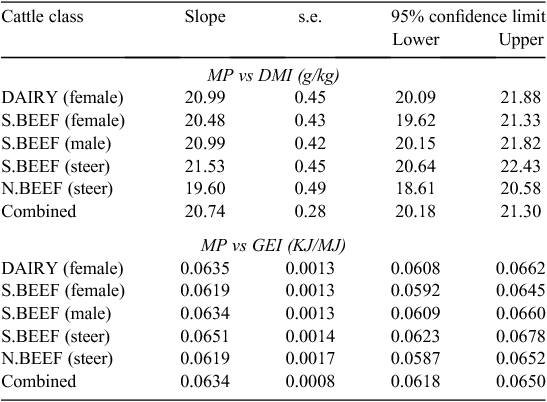
|
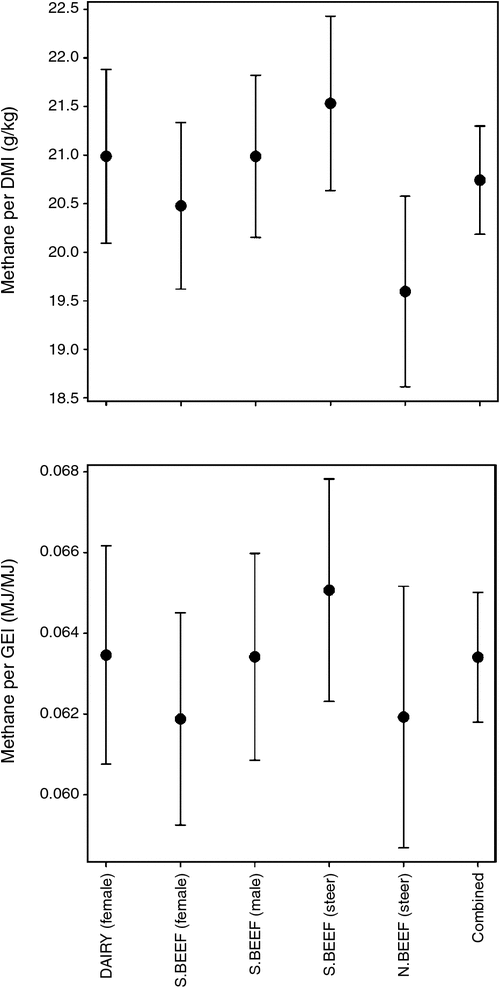
|
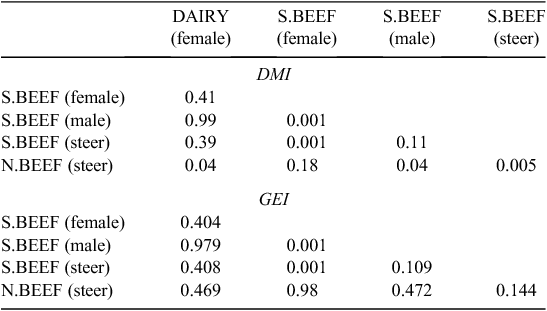
|
Further simplification of the fixed effects, to a single line-through-the-origin, gave the combined estimate of slope as

where MP is in g/day and DMI in kg/day (Table 4, Figs 1, 2). Despite appearances, results of Tables 4 and 5 are not inconsistent. Unlike the confidence intervals for the individual slopes given in Table 4 and Fig. 2, the pairwise tests in Table 5 are designed for testing differences and, therefore, take into account the shared structure in the experimental and sampling design. For example, for S.BEEF, female and male, or female and steer, sometimes occurred together within the same experiment. This resulted in a more precise comparison of their slopes that is not reflected in their individual confidence intervals.
Estimates of the variance components for MP, expressed in Table 6 as standard deviations for ease of interpretation, were calculated under the mixed model having minimal fixed-effects consisting of a common single straight line through the origin. The largest components of variance all pertained exclusively to dairy data. These were, in a decreasing order, the dairy residual variance, dairy experiment variance and dairy period variance. The residual standard deviation for dairy was approximately four-fold the residual standard deviations for the beef classes. The variance component for beef experiment was of an order of magnitude similar to the residual variances. The variance component for treatment was the smallest component, consistent with anti-methanogenic treatments having been excluded from the data. While components have been tabulated in Table 6 only for the simplest fixed-effect model, the estimates derived from other models were very similar and have not been presented here.
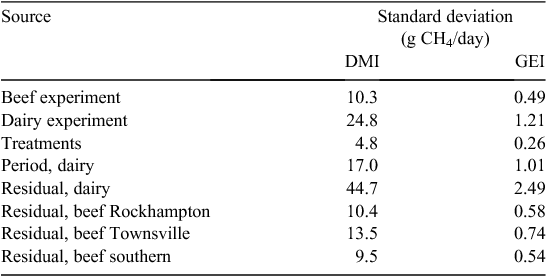
|
Methane production and GE intake
For N.BEEF data, individual GE concentrations were measured and used for each feed. The mean GE concentration for the N.BEEF diets was 17.7 MJ/kg DM. As a consequence of the relativity between mass and energy, results expressed on an energy basis were essentially the same as those expressed on a DM basis. The one exception was for N.BEEF data, where there was a 5% increase in methane yield (MY) on an energy basis versus a DM basis. This is most apparent in Fig. 2 where the mean MP values are given for the five class by sex groups. As with MP on a DM basis, a single line-through-the-origin gave the combined estimate of slope as

where MP and GEI are in MJ/day (Table 4, Fig. 2). Slope did not differ significantly between N.BEEF steers and other class-by-sex groups, as it did on the basis of DM intake (Table 5).
Discussion
Methane and DMI
There is a single, strong, linear relationship between MP and DMI across all classes of forage-fed cattle in Australia (Eqn 1). This is despite the data being collated from experiments conducted at four different research sites, using a wide range of diets typical of those fed to cattle on Australian farms, and involving 220 lactating Holstein dairy cows, 680 Angus beef cattle, including yearling heifers, 2-year-old bulls and steers and 134 Brahman steers. Equation 1 was developed from the most comprehensive dataset relevant to the Australian cattle industries and is strong (P < 0.001, R2 = 0.92). In addition, the methane-emission measurements in this dataset were all made using respiration chambers, a method generally accepted as the most accurate of those currently available (Storm et al. 2012). For these reasons, we propose Eqn 1 as a universal equation to describe methane emissions from all forage-fed cattle in Australia.
A linear relationship between MP and DMI has also been shown by other researchers. Ricci et al. (2013) reported that DMI for beef cattle accounted for 70% of the variation in MP in a meta-analysis of 38 published international studies on dairy and beef cattle. Their data included methane measurements made by both respiration chambers and by the SF6 technique of Johnson et al. (1994), and this may account for some of the variance in their dataset. Hristov et al. (2013a, 2013b) also demonstrated a simple relationship between MP and DMI in a meta-analysis of dairy data that included DMI over a range similar to that in the current analysis (MP (g/day) = 19.14 × DMI + 2.54). Similarly, Dijkstra et al. (2011) reported that methane yield (MY, g CH4/kg DMI) for dairy cows in The Netherlands was 23.1, suggesting a linear relationship between MP and DMI, with an intercept of zero.
In contrast, a curvilinear relationship between MP and DMI was developed by Blaxter and Clapperton (1965), and subsequently corrected by Wilkerson et al. (1995). Recently, Moate et al. (2014) listed six reasons why the equation of Blaxter and Clapperton (1965) should not be used for Australian cattle, including that the work was undertaken predominantly using sheep and feeds that are qualitatively different from the forage-based diets typically used in Australia. A curvilinear relationship based on the chemical composition of the diet is used to estimate emissions from dairy cattle in the United States (Rotz et al. 2011). Reported curvilinearity between MP and DMI is most likely due to an increasing proportion of concentrate in the diet (Rotz et al. 2011). The purpose of our analysis was to develop a universal equation for forage-fed cattle in Australia, which represents a substantial proportion of the Australian beef and dairy industries that are pasture or forage-based. The equation neither uses data from cattle fed over 30% concentrate in the diet, nor is it intended to be used for estimating emissions from such cattle. Constraining our dataset to low concentrate-inclusion levels may explain the lack of curvilinearity at higher intakes observed in our analysis.
Methane yield
The slope of the proposed universal relationship between methane and DMI was similar to previously published values. For dairy cattle alone, the MY was 21.0 ± 0.45 g/kg DMI, which compares well with values reported in the scientific literature that range from ~17 g methane per kg DMI to a maximum of ~25 g/kg DMI. Grainger et al. (2007) summarised data from Australian dairy cows and found a low yield of methane of 17.1 g/kg DMI. While some of the Grainger data were included in the present analysis, the current dairy dataset excludes all data where the concentrate proportion of the diet was over 30% and also includes data obtained since 2007 (Moate et al. 2014). The dairy MY is a little below that of 23.1 g CH4/kg DMI reported by Dijkstra et al. (2011) for dairy cows in The Netherlands and slightly higher than the 19.1 g CH4/kg DMI reported by Hristov et al. (2013a, 2013b). The analysis by Hristov et al. (2013a, 2013b) included high-concentrate diets and this probably contributed to the slightly lower MY than in our analysis.
For the classes of beef cattle used, MY ranged from 19.6 ± 0.49 to 21.5 ± 0.45 g/kg DMI, which is within previously published values. Irish beef data suggested a higher MY of ~25 g/kg DMI (Yan et al. 2009), with a reasonable relationship between MP and DMI (R2 = 0.68). Their analysis included trials with growing beef cattle-fed diets containing 0–70% concentrate. This discrepancy between Irish and Australian data may be attributed to the predominance of extensively fermented grass silages in many of the Irish studies. Ensiling is known to increase GE concentration as some fermentation products have a higher energy value than has non-fermented carbohydrate. However, this effect would still be too small to account for all of the difference in MP. Recent research from the United Kingdom (Hammond et al. 2014) supports Irish research (Yan et al. 2000) showing that MY is higher for ensiled forages. Hammond et al. (2014) found MY to be between 28.0 and 28.9 g/kg DMI for ryegrass and ryegrass–legume silages. However, when similar forages were grazed, MY was <23 g/kg DMI. It should be noted that Hammond et al. (2014) used respiration chambers for the silage study, while the SF6 technique was used for the grazing study. In the United States, calculations for estimating national emissions rely on an empirical approach for beef cattle based on Tier 2 methods for feedlots (USDA 2011). With a baseline methane yield on an energy basis of 3% GE, the value is modified on the basis of the nature of the diet being fed. The nearest relationship to a high-forage diet is a MY of 4.2% for diets with less than 45% concentrate. Using this relationship, US estimates are markedly below those we propose for Australian growing–finishing beef cattle (Fig. 3).
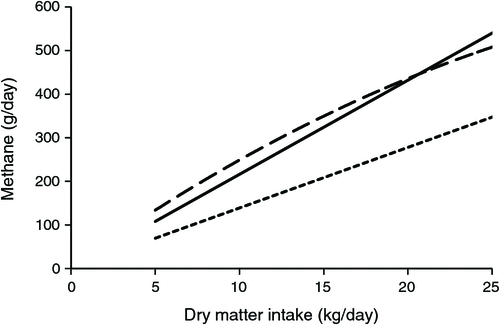
|
It has been reported that MY decreases with increasing concentrate in the diet (Tyrrell and Moe 1972) and can be as low as 3% of GEI (Johnson and Johnson 1995) for diets with a high proportion (>60%) of concentrate. Many forage-based dairy feeding systems typically include a low level of concentrate feeding to reduce possible deficiencies in ruminally available nitrogen or soluble carbohydrate (Doyle et al. 2005). In the current analysis, we selected a maximum concentrate percentage of 30% on the basis of the assumption that rumen fermentation and MY are not significantly affected up to this concentration (Sauvant et al. 2011).
Limitations of the dataset
The current dataset is potentially confounded in several ways that could influence the validity of the relationship.
Animals of different ages were used in the DAIRY and BEEF datasets, with correspondingly different DMI and MP values. Measurements in the DAIRY dataset were from lactating Holstein–Friesian dairy cows with a high DMI and high MP, while measurements in the BEEF dataset were from growing young stock with a low DMI and low MP. The analysis did not include any data for young growing dairy heifers or mature beef breeder cattle.
A sex effect was detected for the S.BEEF dataset, where males, heifers and steers were evaluated. All measurements in the N.BEEF dataset were taken on steers and those in the DAIRY dataset were from lactating cows, so a possible sex effect in Bos indicus and dairy was not able to be tested.
Different diets were used at different experimental sites and diet is well known to affect methane production (e.g. Hristov et al. 2013a). The DAIRY and N.BEEF data are based on a wide variety of diets, with generally few observations per diet, while the S.BEEF data were mainly derived from a very large dataset where the diet quality was deliberately standardised. Site of digestion can be influenced by the form in which the forage is fed. Fresh and grazed forages are more extensively degraded in the rumen than are hays and dried forages (Holden et al. 1994). This could have influenced MP in the DAIRY data versus S.BEEF and N.BEEF data, since the DAIRY data included fresh forages, whereas the majority of BEEF data were collected from cattle fed dried forages. Furthermore, within the beef breeds, all data for tropical forages were generated from Bos indicus cattle, while temperate forage data were generated from Bos taurus cattle. It cannot be discounted that the 5% lower MY on an energy basis in N.BEEF data may have been due to genetic differences. Bos indicus × Bos taurus steers have been shown to produce ~10% less methane than Bos taurus steers of comparable weight and age (Vercoe 1970). Generally, it is considered that tropical grasses are associated with higher methane emissions per unit of DMI than are temperate grasses (Kurihara et al. 1999; Ulyatt et al. 2002) due to higher lignification and subsequent lower rate of passage of feed. However, direct comparisons between tropical and temperate grasses are scarce (e.g. Margan et al. 1988; Archimède et al. 2013). Archimède et al. (2011) conducted a meta-analysis of 22 studies and concluded that methane emissions were 12% higher for ruminants fed C4 (tropical) grasses than for those fed C3 (temperate) grasses. Their analysis employed a range of techniques, including the SF6 technique, and a range of livestock species, including sheep and goats. Our data, which are restricted to cattle and measurements made in respiration chambers, clearly showed that MY was no higher for Bos indicus cattle fed C4 (tropical) grasses, than from Bos taurus cattle fed C3 (temperate) grasses.
In an analysis of this type, it is impossible to eliminate all factors that may have contributed to some of the statistical ‘noise’. The apparent positive relationship of residual variance with MP may have been an artefact of experimental conditions at different sites and the observation of a sex effect in the S.BEEF data may have been an artefact of data measurement or selection. Nevertheless, we believe that the effects of these factors, if present, were too small to markedly influence the results, and this is borne out by the strong regression statistic (R2 = 0.92) of the universal relationship. In addition, the current dataset, with over a thousand individual measurements of MP from cattle in open-circuit respiration chambers, is very much larger that the datasets used to establish the current Tier 2 estimates of methane emissions used in the Australian inventory.
Choice of statistical approach
The discussion around the statistical approach is confined to MP on a DM basis, because the same arguments and conclusions would also apply to MP expressed on an energy basis.
The data for the current meta-analysis were derived from experiments that were not planned as a whole series. Consequently, the data were both experimental and observational, involving a certain amount of imbalance and confounding due to differences between sites and the choices of experimental protocols, animal type and sex. The challenge for the present meta-analysis was to detect and represent the structure in the data in an efficient and realistic manner, so as to reliably select and estimate models descriptive of MP. A mixed-model framework was well suited to this end (St-Pierre 2001; Sauvant et al. 2008).
The purpose of the random effects was, first, to account for lack of independence arising by virtue of the data being grouped according to their site, experiment, time and experimental structure. Second, additional random effects were included to account for variance heterogeneity apparent in the data. This was achieved by the inclusion of multiple residual variances, one for each location from which the data were sourced. These four locations utilised different respiration chambers and experimental protocols that could have contributed to differing variances. Furthermore, these locations each measured just one class of animal, for which there were different ranges of DMI and thus also of MP. In particular, it was found that dairy, with its greater DMI and MP had greater variance, not only within, but also between experiments. Random effects were included specifically to account for this heterogeneity.
Variations of this approach to the meta-analysis were investigated. For example, log-transformation of MP before analysis was effective in removing much of variance heterogeneity, but it did not completely remove it. It did obviate the need for a special variance component for dairy experiments. Log-transformation, while maintaining the convenience of a linear model, implied a change in the form of the MP versus DMI relationship to that of a power curve. With this, a straight line through the origin occurs as a special case, when slope coefficient for log-DMI equals unity.
A third approach, noting that variance increases with both MP and DMI, was to analyse MY (i.e. the data formed by the ratio MP : DMI) directly. This too reduced variance heterogeneity, but not completely. It also simplified the fixed-effects model to one without DMI, or raised a perceived difficulty of dealing with DMI on both sides of the model equation.
All approaches tested produced similar estimates of slopes of the straight line between MP and DMI, through the origin. As all approaches require a reasonably complex random-effects structure, dictated by the grouped sampling structure, there appears to be no compelling reason to choose one above the other. We adopted the first approach, of analysing MP in terms of DMI by classifying factors, which is analogous to grouped regression, as being conceptually the simplest for the readership.
The case for adopting a single relationship
There was some evidence of non-zero intercepts in relationships between MP and DMI for males and steers within the S.BEEF class. For males, the intercept was less than zero, whereas for steers, the intercept was greater than zero. The reasons for this remain obscure. It is possible that these were in fact Type I errors. Biologically, it makes sense that MP should be zero at zero DMI, so the relationship must eventually go through the origin. This implies that either the straight-line relationship does go through the origin and we were mistaken in allowing for non-zero intercept, or that the true relationship actually involved some curvature. While we cannot exclude the possibility of curvature, it is unlikely that such curvature would manifest at the relatively low levels of DMI observed for these beef data, particularly when it was not apparent at the higher DMI observed for DAIRY. It is also apparent that the S.BEEF (male) and S.BEEF (steer) data do in fact not stray far from a straight line through the origin shared by all of the data (Fig. 4). We also note that a small change in slope can produce a large change in intercept, especially when DMI data are clumped well away from zero. For these reasons, we proceeded to include in our analysis straight-line models constrained to pass through the origin. When this was done, the generalised R2-value actually increased slightly (from 0.915 to 0.924; Tables 3, 4). Apart from its simplicity, the adoption of the straight line through the origin has the added advantage that the slope can be interpreted as the average MY.
The model suggested in the present paper can be used to predict the methane emissions from individual animals, from a herd of animals or emissions with respect to the national inventory. If the model is used to predict methane emissions from an individual animal, then, at a given DMI, the spread of data as shown in Fig. 1 provides an indication of the possible error of prediction. At any given DMI, the observed variation in methane emissions is due to several factors, including differences in diet composition (Johnson and Johnson 1995), variation in the day-to-day feed intake (Moate et al. 2012), genetic differences among animals (Hegarty et al. 2006) and measurement error (Gardiner et al. 2015). Our model indicates that all of these factors may collectively introduce an error of ~13.4% (root-mean-square percentage discrepancy between points and the fitted line) into the prediction of the methane emissions from an individual animal. The ‘leave one experiment out at a time’ cross-validation gave comparable root-mean-square percentage error of prediction of 14.4%. The variance component estates presented in the paper can be used to estimate absolute prediction error for an animal, or for a herd, of a particular class. However, if the model is used to estimate the methane emissions for the national inventory, then, on the basis of Eqn 1, the error of prediction is likely to be ~1.4%.
Current inventory methods versus the universal equation
The current Australian national accounting system (Department of the Environment 2014) uses two distinct methods for estimating methane emissions. For dairy cattle and beef cattle in temperate regions, feed intake is based on the equation of Minson and McDonald (1987) corrected for milk production (Standing Committee on Agriculture 1990); then, the equation of Blaxter and Clapperton (1965) as corrected by Wilkerson et al. (1995) is used to predict the MY. For beef cattle in tropical regions, intake is calculated according to Minson and McDonald (1987), whereas MY is based on the equation of Kurihara et al. (1999) as modified by Hunter (2007). The following relationships between MP and DMI were derived using the methods of Australian Inventory of Greenhouse Gases (Department of the Environment 2014):



where MP is methane production (g/day) for dairy cattle and beef cattle in southern or northern Australia.
These relationships generally estimate a higher MP than does the new universal equation (Fig. 5). Estimates of MP for dairy cattle were reduced by ~10% at DMI up to 15 kg/day. Above this DMI, the curvilinearity of the current method used for accounting diminished the difference between the two relationships, such that at DMI above 23 kg/day, the proposed linear equation predicted marginally higher emissions. For beef cattle in temperate regions, estimates of MP were between 5% and 20% lower than the current inventory estimate across the likely intake range of growing beef cattle. For beef cattle in tropical regions, the reduction in estimated MP ranged from 25% to 30%.
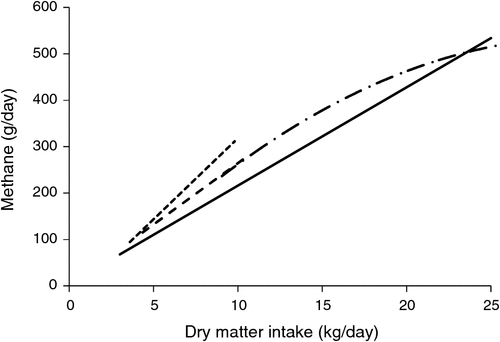
|
Using the proposed linear equation dramatically reduces emission estimates from enteric fermentation of Australia’s beef and dairy cattle (Table 7). By applying the universal equation to the 2012 inventory data (Department of the Environment 2014) and applying a global warming potential (GWP) of 21 from the 2012 inventory, emissions from cattle are reduced by 10.6 Mt (CO2-e) or 24.1%. This would reduce the total contribution of agriculture from 16.1% to 14.1% of national GHG emissions. Under the proposed inventory methodology for the next accounting period, a GWP for methane of 25 will be used to recalculate the inventory back to 1990 (Department of the Environment 2015). If the current equations were used, the estimated total emissions from the cattle industries would be 52.1 Mt (CO2-e), whereas by applying the new relationship, the emissions are calculated as 39.5 Mt (CO2-e). Thus, the new universal equation predicts 12.6 Mt (CO2-e) less emissions.
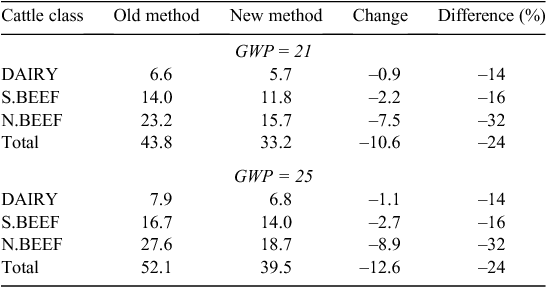
|
Compared with the 2102 inventory with a GWP of 21, the combined effect of the new universal equation and a GWP of 25 would result in estimates of 0.2 Mt CO2-e more emission for DAIRY, no change for S.BEEF, 4.5 Mt CO2-e less emissions for N.BEEF, and a net reduction in the total estimated inventory for cattle of 4.3 Mt CO2-e annually.
Summary and conclusions
On the basis of the most comprehensive dataset for methane emissions measured in open-circuit respiration chambers in Australia, the case is made to revise the methods used for calculating the national inventory for forage-fed cattle. The results showed that a single relationship for dairy and all beef cattle is justified, considering the inconsequential differences found between the dairy and beef cattle in the tropical northern and temperate southern regions of Australia. It is proposed that for the national inventory, a single relationship for forage-based diets (forage content of >70%) between MP and DMI of 20.7 g/kg DM should be adopted when GE content of the diet is unknown and assumed to be similar to the default value of 18.4 MJ/kg DM. If the GE concentration of the diet is known, then an energy loss as methane of 6.3% of GE is recommended. We do not support a more complex relationship that takes into account diet quality, rate of passage, class of cattle and physiological state on the presumption that the animal integrates these and other variables into the total feed eaten when consuming forage-based diets. Voluntary DMI is a product of both plant and animal characteristics affecting digestion and, as such, represents a suitable basis for estimating methane emissions.
Acknowledgements
This review was funded by the Australian Department of the Environment and is based on research largely funded through the Reducing Emissions from Livestock Research Program, and National Livestock Methane Program, both coordinated by Meat and Livestock Australia (MLA) and co-funded by the Australian Government and MLA. The assistance provided by Nigel Tomkins and Lindsey Perry in the provision of additional data is gratefully acknowledged. Additional advice on statistical analysis was also provided by Dr Julian Hill.
References
Archimède H, Eugène M, Marie-Magdeleine C, Boval M, Martin C, Morgavi DP, LeComte P, Doreau M (2011) Comparison of methane production between C3 and C4 grasses and legumes. Animal Feed Science and Technology 166–167, 59–64.| Comparison of methane production between C3 and C4 grasses and legumes.Crossref | GoogleScholarGoogle Scholar |
Archimède H, Rira M, Eugene M, Morgavi DP, Anais C, Periacarpin F, Calif B, Martin C, Marie-Magdeleine C, Doreau M (2013) Intake, total-tract digestibility and methane emission of Texel and Blackbelly sheep fed C4 and C3 grasses tested simultaneously in a temperate and a tropical area. Advances in Animal Biosciences 4, 285
Australian Greenhouse Emissions Information System (2014) ‘National greenhouse gas inventory: Kyoto protocol accounting framework.’ Available at http://ageis.climatechange.gov.au/# [Verified 29 July 2014]
Blaxter KL, Clapperton JL (1965) Prediction of the amount of methane produced by ruminants. British Journal of Nutrition 19, 511–522.
| Prediction of the amount of methane produced by ruminants.Crossref | GoogleScholarGoogle Scholar | 1:CAS:528:DyaF28XitFKktg%3D%3D&md5=2a0b9f2ba383587ab81bcf6489c6b257CAS | 5852118PubMed |
Brouwer E (1965) Report of subcommittee on constants and factors. In ‘Proceedings of the 3rd EAAP symposium on energy metabolism’. Publ. 11. (Ed. KL Blaxter) pp. 441–443. (Academic Press: London, UK)
Deighton MH, Williams SRO, Hannah MC, Eckard RJ, Boland TM, Wales WJ, Moate PJ (2014) A modified sulphur hexafluoride tracer technique enables accurate determination of enteric methane emissions from ruminants. Animal Feed Science and Technology 197, 47–63.
| A modified sulphur hexafluoride tracer technique enables accurate determination of enteric methane emissions from ruminants.Crossref | GoogleScholarGoogle Scholar | 1:CAS:528:DC%2BC2cXhsVSqsbvO&md5=87f7b0e86e5b782831341929c05182eeCAS |
Department of the Environment (2014) National inventory report 2012, vol. 1. Commonwealth of Australia, Canberra. Available at http://www.environment.gov.au/climate-change/greenhouse-gas-measurement/publications#national [Verified 25 August 2014]
Department of the Environment (2015) ‘National greenhouse and energy reporting (measurement) amendment determination 2015 (No. 1).’ Departmental Commentary. http://www.environment.gov.au/consultation-draft-nger-amendmant-determination-2015-no1-departmental-commentry.doc [Verified 30 June 2015]
Dijkstra J, Van Zijderveld SM, Apajalahti JA, Bannink A, Gerrits WJJ, Newbold JR, Perdok HB, Berends H (2011) Relationships between methane production and milk fatty acid profiles in dairy cattle. Animal Feed Science and Technology 166–167, 590–595.
| Relationships between methane production and milk fatty acid profiles in dairy cattle.Crossref | GoogleScholarGoogle Scholar |
Donoghue KA, Herd RM, Bird SH, Arthur PF, Hegarty RS (2013) Preliminary genetic parameters for methane yield in Australian beef cattle. In ‘Proceedings of the Association for the Advancement of Animal Breeding and Genetics. Vol. 20’. (Ed. NL Villalobos) pp. 290–293. (Association for the Advancement of Animal Breeding and Genetics: Napier, NZ)
Doyle PT, Francis SA, Stockdale CR (2005) Associative effects between feeds when concentrate supplements are fed to grazing dairy cows: a review of likely impacts on metabolizable energy supply. Australian Journal of Agricultural Research 56, 1315–1329.
| Associative effects between feeds when concentrate supplements are fed to grazing dairy cows: a review of likely impacts on metabolizable energy supply.Crossref | GoogleScholarGoogle Scholar |
Galwey NW (2006) ‘Introduction to mixed modelling, beyond regression and analysis of variance.’ (John Wiley & Sons: Chichester, UK)
Gardiner TD, Coleman MD, Innocenti F, Tompkins J, Connor A, Garnsworthy PC, Moorby JM, Reynolds CK, Waterhouse A, Wills D (2015) Determination of the absolute accuracy of UK chamber facilities used in measuring methane emissions from livestock. Measurement: Journal of the International Measurement Confederation 66, 272–279.
| Determination of the absolute accuracy of UK chamber facilities used in measuring methane emissions from livestock.Crossref | GoogleScholarGoogle Scholar |
Grainger C, Clarke T, McGinn SM, Auldist MJ, Beauchemin KA, Hannah MC, Waghorn GC, Clark H, Eckhard RJ (2007) Methane emissions from dairy cows measured using sulphur hexafluoride (SF6) tracer and chamber techniques. Journal of Dairy Science 90, 2755–2766.
| Methane emissions from dairy cows measured using sulphur hexafluoride (SF6) tracer and chamber techniques.Crossref | GoogleScholarGoogle Scholar | 1:CAS:528:DC%2BD2sXlvFOitr0%3D&md5=31e9af0171520957adc3a531ed7b340bCAS | 17517715PubMed |
Grainger C, Auldist MJ, Clarke T, Beauchemin KA, McGinn SM, Hannah MC, Eckard RJ, Lowe LB (2008) Use of monensin controlled-release capsules to reduce methane emissions and improve milk production of dairy cows offered pasture supplemented with grain. Journal of Dairy Science 91, 1159–1165.
| Use of monensin controlled-release capsules to reduce methane emissions and improve milk production of dairy cows offered pasture supplemented with grain.Crossref | GoogleScholarGoogle Scholar | 1:CAS:528:DC%2BD1cXivFemtb8%3D&md5=4f1e454f49c2e52137e628ad5aba972cCAS | 18292272PubMed |
Grainger C, Williams SRO, Eckard RJ, Hannah MC (2010) A high dose of monensin does not reduce methane emissions of dairy cows offered pasture supplemented with grain. Journal of Dairy Science 93, 5300–5308.
| A high dose of monensin does not reduce methane emissions of dairy cows offered pasture supplemented with grain.Crossref | GoogleScholarGoogle Scholar | 1:CAS:528:DC%2BC3MXnsl2qsA%3D%3D&md5=2876474c7da48572f49621f5d02f3798CAS | 20965346PubMed |
Hammond KJ, Humphries DJ, Westbury DB, Thompson A, Crompton LA, Kirton P, Green C, Reynolds CK (2014) The inclusion of forage mixtures in the diet of growing dairy heifers: impacts on digestion, energy utilization, and methane emissions. Agriculture, Ecosystems & Environment 197, 88–95.
| The inclusion of forage mixtures in the diet of growing dairy heifers: impacts on digestion, energy utilization, and methane emissions.Crossref | GoogleScholarGoogle Scholar | 1:CAS:528:DC%2BC2cXhtlahs7rL&md5=0ceb902096afdc343c75d3bad3e69583CAS |
Hegarty RS, Goopy JP, Herd RM, McCorkell B (2006) Cattle selected for lower residual feed intake have reduced daily methane production. Journal of Animal Science 85, 1479–1486.
| Cattle selected for lower residual feed intake have reduced daily methane production.Crossref | GoogleScholarGoogle Scholar |
Hegarty R, Bird S, Woodgate R (2014) Chapter 2: cattle respiration facility, Armidale, New South Wales, Australia. In ‘Technical manual on respiration chamber designs’. (Eds C Pinares, G Waghorn) pp. 31–44. (Ministry of Agriculture and Forestry: Wellington, NZ) Available at http://www.globalresearchalliance.org/app/uploads/2012/03/GRA-MAN-Facility-BestPract-2012-FINAL.pdf [Verified 31 July 2014]
Herd RM, Donoghue KA, Arthur PF, Bird SH, Bird-Gardiner T, Hegarty RS (2014) Measures of methane production and their phenotypic relationships with growth and body composition traits in beef cattle. Journal of Animal Science 92, 5267–5274.
| Measures of methane production and their phenotypic relationships with growth and body composition traits in beef cattle.Crossref | GoogleScholarGoogle Scholar | 1:CAS:528:DC%2BC2MXitlartw%3D%3D&md5=eeea3b2021510cca2a9772b3f048c2b8CAS | 25349368PubMed |
Holden LA, Miller LD, Varga GA, Hillard PJ (1994) Ruminal digestion and duodenal nutrient flows in dairy cows consuming grass as pasture, hay, or silage. Journal of Dairy Science 77, 3034–3042.
| Ruminal digestion and duodenal nutrient flows in dairy cows consuming grass as pasture, hay, or silage.Crossref | GoogleScholarGoogle Scholar | 1:STN:280:DyaK2M7jvVensw%3D%3D&md5=4605db6c5b038bfec82097f3bdf1bb45CAS | 7836591PubMed |
Hristov AN, Oh J, Firkins JL, Dijkstra J, Kebreab E, Waghorn GC, Makkar HPS, Adesogan AT, Yang W, Lee C, Gerber PJ, Henderson B, Tricarico JM (2013a) Mitigation of methane and nitrous oxide emissions from animal operations: I. A review of enteric methane mitigation options. Journal of Animal Science 91, 5045–5069.
| Mitigation of methane and nitrous oxide emissions from animal operations: I. A review of enteric methane mitigation options.Crossref | GoogleScholarGoogle Scholar | 1:CAS:528:DC%2BC3sXhslKktrrL&md5=232196d68807bd4a5064908acacdfea8CAS | 24045497PubMed |
Hristov AN, Oh J, Lee C, Meinen R, Montes F, Ott T, Firkins J, Rotz A, Dell C, Adesogan A, Ang WZ, Tricarico J, Kebreab E, Waghorn GC, Dijkstra J, Oosting S (2013b) ‘Mitigation of greenhouse gas emissions in livestock production: a review of technical options for non-CO2 emissions. FAO animal production and health. Paper no. 177.’ (Eds P Gerber, B Henderson, H Makkar) (FAO: Rome, Italy)
Hunter RA (2007) Methane production by cattle in the tropics. British Journal of Nutrition 98, 657
| Methane production by cattle in the tropics.Crossref | GoogleScholarGoogle Scholar | 1:CAS:528:DC%2BD2sXhtFKms7%2FO&md5=eec61700bde5d1b6750dc54032bc098dCAS | 17896417PubMed |
IPCC (2000) ‘Good practice guidance and uncertainty management in National Greenhouse Gas Inventories.’ (Intergovernmental Panel on Climate Change: Kanagawa, Japan)
Johnson KA, Johnson DE (1995) Methane emissions from cattle. Journal of Animal Science 73, 2483–2492.
Johnson K, Huyler M, Westberg H, Lamb B, Zimmerman P (1994) Measurement of methane emissions from ruminant livestock using a SF6 tracer technique. Environmental Science & Technology 28, 359–362.
| Measurement of methane emissions from ruminant livestock using a SF6 tracer technique.Crossref | GoogleScholarGoogle Scholar | 1:CAS:528:DyaK2cXmtFahtA%3D%3D&md5=0064e1a5426af33063e026a8886af305CAS |
Kennedy PM, Charmley E (2012) Methane yields from Brahman cattle fed tropical grasses and legumes. Animal Production Science 52, 225–239.
| Methane yields from Brahman cattle fed tropical grasses and legumes.Crossref | GoogleScholarGoogle Scholar | 1:CAS:528:DC%2BC38XktFWgsL0%3D&md5=d46d8c9c3d5213d759f8d89573b1c788CAS |
Kurihara M, Magner T, Hunter RA, McCrabb GJ (1999) Methane production and energy partition of cattle in the tropics. British Journal of Nutrition 81, 227–234.
| Methane production and energy partition of cattle in the tropics.Crossref | GoogleScholarGoogle Scholar | 1:CAS:528:DyaK1MXjtFSntLc%3D&md5=d701210f7a7a478de00f3ce0e580c738CAS | 10434849PubMed |
Margan DE, Graham NMcC, Minson DJ, Searle TW (1988) Energy and protein values of four forages, including a comparison between tropical and temperate species. Australian Journal of Experimental Agriculture 28, 729–736.
| Energy and protein values of four forages, including a comparison between tropical and temperate species.Crossref | GoogleScholarGoogle Scholar |
Minson DJ, McDonald CK (1987) Estimating forage intake from the growth of beef cattle. Tropical Grasslands 21, 116–122.
Moate PJ, Deighton MH, Hannah MC, Williams SRO (2012) Intake effects on methane emissions from dairy cows. In ‘The CCRSPI conference, Melbourne, 27–29 November 2012’. pp. 60–61. (Climate Change Research Strategy for Primary Industries: Melbourne)
Moate PJ, Williams SRO, Torok VA, Hannah MC, Eckard RJ, Auldist MJ, Ribaux BE, Jacobs JL, Wales WJ (2013) Effects of feeding algal meal high in docosahexanoic acid on feed intake milk production and methane emissions in dairy cows. Journal of Dairy Science 96, 3177–3188.
| Effects of feeding algal meal high in docosahexanoic acid on feed intake milk production and methane emissions in dairy cows.Crossref | GoogleScholarGoogle Scholar | 1:CAS:528:DC%2BC3sXktFaksb8%3D&md5=21a1a908e2ecf8ba151909af8b58a990CAS | 23498011PubMed |
Moate PJ, Williams SRO, Deighton MH, Pryce JE, Hayes BJ, Jacobs JL, Eckard RJ, Hannah MC, Wales WJ (2014) Mitigation of enteric methane emissions from the Australian dairy industry. In ‘Proceedings of the 6th Australasian dairy science symposium’. (Ed. J Roche) pp. 121–136. (Australasian Dairy Science Symposium: Hamilton, NZ)
Nakagawa S, Schieizeth S (2013) A general and simple method for obtaining R 2 from general linear mixed effects models. Methods in Ecology and Evolution 4, 133–142.
| A general and simple method for obtaining R 2 from general linear mixed effects models.Crossref | GoogleScholarGoogle Scholar |
NHMRC (2004) ‘Australian code of practice for the care and use of animals for scientific purposes.’ 7th edn. (Commonwealth of Australia: Canberra)
Ricci P, Rooke JA, Nevison I, Waterhouse A (2013) Methane emissions from beef and dairy cattle: quantifying the effect of physiological stage and diet characteristics. Journal of Animal Science 91, 5379–5389.
| Methane emissions from beef and dairy cattle: quantifying the effect of physiological stage and diet characteristics.Crossref | GoogleScholarGoogle Scholar | 1:CAS:528:DC%2BC3sXhslKkt7jM&md5=cea0bb4fda3d922c50b65f572c85c9dfCAS | 24174549PubMed |
Rotz CA, Corson MS, Chianese DS, Montes F, Hafner SD, Coiner CU (2011) ‘Integrated farm system model: reference manual.’ (US Department of Agriculture, Agricultural Research Service: University Park, PA) Available at http://ars.usda.gov/SP2UserFiles/Place/19020000/ifsmreference.pdf [Verified 29 August 2014]
Sauvant D, Schmidely P, Daudin JJ, St-Pierre NR (2008) Meta-analyses of experimental data in animal nutrition. Animal 2, 1203–1214.
| Meta-analyses of experimental data in animal nutrition.Crossref | GoogleScholarGoogle Scholar | 1:STN:280:DC%2BC38vptFShsA%3D%3D&md5=15242cd8839a5eac152ead26a9ccf693CAS | 22443733PubMed |
Sauvant D, Giger-Reverdin S, Serment A, Broudiscou L (2011) Influences des régimes et de leur fermentation dans le rumen sur la production de méthane par les ruminants. INRA Production Animaux 24, 433–446.
St-Pierre NR (2001) Invited review: integrating quantitative findings from multiple studies using mixed model methodology. Journal of Dairy Science 84, 741–755.
| Invited review: integrating quantitative findings from multiple studies using mixed model methodology.Crossref | GoogleScholarGoogle Scholar | 1:CAS:528:DC%2BD3MXjtFyks78%3D&md5=99f6aa06c7acd11b5026e77a1aa07e72CAS | 11352149PubMed |
Standing Committee on Agriculture (1990) ‘Feeding standards for Australian livestock ruminants.’ (CSIRO Publishing: Melbourne)
Storm IM, Hellwing ALF, Nielsen NI, Madsen J (2012) Methods for measuring and estimating methane emission from ruminants. Animals (Basel) 2, 160–183.
| Methods for measuring and estimating methane emission from ruminants.Crossref | GoogleScholarGoogle Scholar | 26486915PubMed |
Tomkins NW, McGinn SM, Turner DA, Charmley E (2011) Comparison of two methods for measuring methane emissions from beef cattle grazing Rhodes grass dominated pastures. Animal Feed Science and Technology 166–167, 240–247.
| Comparison of two methods for measuring methane emissions from beef cattle grazing Rhodes grass dominated pastures.Crossref | GoogleScholarGoogle Scholar |
Tyrrell HF, Moe PW (1972) Net energy value for lactation of a high and low concentrate ration containing corn silage. Journal of Dairy Science 55, 1106–1112.
| Net energy value for lactation of a high and low concentrate ration containing corn silage.Crossref | GoogleScholarGoogle Scholar |
Ulyatt MJ, Lassey KR, Shelton ID, Walker CF (2002) Methane emission from dairy cows and wether sheep fed subtropical grass-dominant pastures in midsummer in New Zealand. New Zealand Journal of Agricultural Research 45, 227–234.
| Methane emission from dairy cows and wether sheep fed subtropical grass-dominant pastures in midsummer in New Zealand.Crossref | GoogleScholarGoogle Scholar | 1:CAS:528:DC%2BD3sXhtVykt7Y%3D&md5=57c9e8a1e70d45cca81f639e2f66900fCAS |
United States Department of Agriculture (2011) Quantifying greenhouse gas sources and sinks in animal production systems. In ‘Greenhouse gas estimation. Quantifying greenhouse gas fluxes in agriculture and forestry: methods for entity-scale inventory’. pp. 5–159. (Office of the Chief Economist, USDA: Washington, DC) Available at www.usda.gov/oce/climate_change/estimation.htm [Verified 10 July 2015]
Vercoe JE (1970) Fasting metabolism and heat increment of feeding in Brahman × British and British cross cattle. In ‘Energy metabolism of farm animals’. EAAP Publication No. 13. (Eds A Schurch, C Wenk) pp. 85–88. (Juris Druck and Verlag Zurich: Zurich, Switzerland)
Wilkerson VA, Casper DP, Mertens DR (1995) The prediction of methane production of Holstein cows by several equations. Journal of Dairy Science 78, 2402–2414.
| The prediction of methane production of Holstein cows by several equations.Crossref | GoogleScholarGoogle Scholar | 1:CAS:528:DyaK28XhtFOrtA%3D%3D&md5=ac345018e88bf971f330f478c16be111CAS | 8747332PubMed |
Williams SRO, Clark T, Hannah MC, Marett LC, Moate PJ, Auldist MJ, Wales WJ (2013) Energy partitioning in herbage-fed dairy cows offered supplementary grain during an extended lactation. Journal of Dairy Science 96, 484–494.
| Energy partitioning in herbage-fed dairy cows offered supplementary grain during an extended lactation.Crossref | GoogleScholarGoogle Scholar | 1:CAS:528:DC%2BC38XhvV2ktbfL&md5=104899176baf949ec2f83d7957d31aa8CAS |
Yan T, Agnew RE, Gordon FJ, Porter MG (2000) Prediction of methane energy output in dairy and beef cattle offered grass silage-based diets. Livestock Production Science 64, 253–263.
| Prediction of methane energy output in dairy and beef cattle offered grass silage-based diets.Crossref | GoogleScholarGoogle Scholar |
Yan T, Porter MG, Mayne CS (2009) Prediction of methane emission from beef cattle using data measured in indirect open-circuit respiration chambers. Animal 3, 1455–1462.
| Prediction of methane emission from beef cattle using data measured in indirect open-circuit respiration chambers.Crossref | GoogleScholarGoogle Scholar | 1:CAS:528:DC%2BD1MXhtlGnsb7N&md5=5ae810a3cc1a196a0e9a793d36407fa7CAS | 22444941PubMed |


